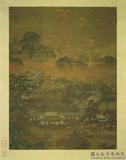宋緙絲蓉塘戲鷺 軸
推薦分享
資源連結
連結到原始資料 (您即將開啟新視窗離開本站)後設資料
- 資料識別:
- 故絲000013N000000000
- 資料類型:
- 類型:緙繡、繪畫
- 型式:靜態圖像
- 主題與關鍵字:
- 鷺鷥 芙蓉 蓮荷 萱花 奇石 雲
- 出版者:
- 數位化執行單位:國立故宮博物院
- 格式:
- 本幅 123.5x48.9公分
- 關聯:
- 石渠寶笈三編(乾清宮),第二冊,頁672&*國立故宮博物院緙絲,黑白圖版27&*緙絲特展圖錄,頁40-41、98&*素地設色織,荷塘一隅,岸邊聳立湖石,三隻白鷺鷥悠游其間。芙蓉、荷花、萱草相互爭艷盛放,天空滿佈彩霞,與流水交相輝映,一片生意盎然。全圖以藍、白二色為主,色彩看似單調,卻極富變化,畫面典雅怡人。 此件作品融和了各種「戧」色的緙絲技巧,產生顏色暈染的裝飾效果,如以「長短戧」和「包心戧」等技表現鳥羽軟毛、硬羽的質地,色彩柔和飽滿。「勾」法緙出線條優美的花朵,畫面生動傳神,與宋代寫生作品難分軒輊。&*Woven in colors against a plain background is a scene from a lotus pond. Two decorative rocks rise on the shore as three white egrets leisurely roam among them. Hibiscus, lotus, and daylily blossom and vie for beauty. The sky is filled with a colorful glow reflected in the flowing water beneath, creating for a scene full of life. The image is composed mostly of blue and white that may look monotonous at first but is actually quite varied, giving it a classical and pleasing appearance. This work combines various kinds of “propped” weaving colors, yielding a decorative color wash effect. The “long and short propping” and “wrap propping” techniques, for example, represent both the soft down and stiff feathers of the birds, the hues harmonious and full. The “knotting” method of tapestry weaves the graceful lines of the blossoms. The animated and lifelike quality of the image thus makes it difficult to distinguish from “sketching-from-life” painting of the Sung dynasty.&*1.童文娥,〈緙絲蓉塘戲鷺〉,收入童文娥主編,《緙絲風華 — 宋代緙絲花鳥展圖錄》(臺北:國立故宮博物院,2007年初版一刷),頁17。 2.童文娥,〈宋緙絲蓉塘戲鷺〉,《故宮文物月刊》,第300期(2008年3月),頁46。
- 管理權:
- 國立故宮博物院
授權聯絡窗口
- 國立故宮博物院圖像授權、出版授權、影音資料授權-申請流程說明
http://www.npm.gov.tw/zh-TW/Article.aspx?sNo=03003061






